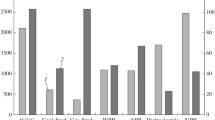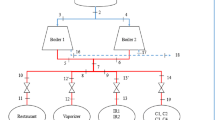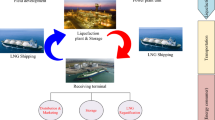Abstract
Cogeneration of electrical energy and heat has become a steadily growing and flourishing segment of energy industry. Application potential of microturbines moved from back-up sources for electrical energy and island operation systems, and expended as a combined source for electrical energy and heat in commercial facilities and residential premises. In this paper, we wish to present an analysis of gas microturbine integration in a commercial laundry. We opted for a professional laundry care since it is a common representative of a well-known process which requires a lot of energy input. We focus on commercial laundries with a capacity over 1000 kg of processed laundry per shift. This type of laundries is very common and has a large innovation potential. The gas microturbine was considered as a cogeneration unit as it has a process-adequate performance (30 kWe). Its flue gas helps heat main laundry input flows: hot water for the washing machines and hot flue gas for the dryers. Incorporation of a progressive technology with a common commercial process gives us a promising application potential for our work. Prices of commercial microturbines are still rather high and short payback period may be expected only if very specific conditions are met.






Similar content being viewed by others
Abbreviations
- cp :
-
Specific heat [kJ/(kg.K)]
- \(\dot{m}\) :
-
Mass flow (kg/s)
- \({\dot{\text{Q}}}\) :
-
Heat flow (kW)
- P:
-
Cost ($/kWh)
- T:
-
Temperature (K, °C)
- DL:
-
Dry linen
- e:
-
Electricity
- f:
-
Flue gas
- g:
-
Natural gas
- h:
-
Heat
- H2O:
-
Water
- AC:
-
Alternating current
- CCHP:
-
Combined cooling, heating and power
- CHP:
-
Combined heat and power
- DC:
-
Direct current
- GMT:
-
Gas microturbine
- GT:
-
Gas turbine
- HE:
-
Heat exchanger
- ICE:
-
Internal combustion engine
- LHV:
-
Low heating value
- NG:
-
Natural gas
- O and M:
-
Operating and maintenance
- RH:
-
Relative humidity
References
Atsalakis GS, Protopapadakis EE, Valavanis KP (2015) Stock trend forecasting in turbulent market periods using neuro-fuzzy systems. Oper Res Int J. doi:10.1007/s12351-015-0197-6
Bobák P, Pavlas M, Máša V, Jegla Z, Kšenzuliak V (2012) Heat recovery in professional laundry care process. Chem Eng Trans 29:391–396. doi:10.3303/CET1229066
Canova A, Chicco G, Genon G, Mancarella P (2008) Emission characterization and evaluation of natural gas-fueled cogeneration microturbines and internal combustion engines. Energy Convers Manage 49:2900–2909. doi:10.1016/j.enconman.2008.03.005
Capehart BL (2014) Microturbines. http://www.wbdg.org/resources/microturbines.php. Accessed 12 Aug 2015
Capstone Turbine Corporation (2015a) Case studies. http://www.capstoneturbine.com/case-studies. Accessed 20 April 2015
Capstone Turbine Corporation (2015b) Specification of microturbine C30. http://www.capstoneturbine.com/products/c30. Accessed 20 April 2015
Comodi G, Renzi M, Caresana F, Pelagalli L (2015) Enhancing micro gas turbine performance in hot climates through inlet air cooling vapour compression technique. Appl Energy 147:40–48. doi:10.1016/j.apenergy.2015.02.076
De Paepe W, Delattin F, Bram S, De Ruyck J (2012) Steam injection experiments in a microturbine – A thermodynamic performance analysis. Appl Energ 97:569–576. doi:10.1016/j.apenergy.2012.01.051
Energy Solutions Center, Inc. (2004) Microturbines. http://www.understandingchp.com/appguide/Chapters/Chap4/4-2_Microturbines.htm. Accessed 22 April 2015
Eurostat (2015) Electricity and natural gas price statistics. http://ec.europa.eu/eurostat/statistics-explained/index.php/Electricity_and_natural_gas_price_statistics. Accessed 9 Sept 2015
Gillette S, Gilbreth M (2013) Microturbines. In: Chakraborty S, Simoes MG, Kramer WE (eds) Power electronics for renewable and distributed energy systems. Springer, London, pp 295–331
Ismail MS, Moghavvemi M, Mahlia TMI (2013) Current utilization of microturbines as a part of a hybrid system in distributed generation technology. Renew Sust Energy Rev 21:142–152. doi:10.1016/j.rser.2012.12.006
Kaikko J, Backman J (2007) Technical and economic performance analysis for a microturbine in combined heat and power generation. Energy 32:378–387. doi:10.1016/j.energy.2006.06.013
Kilkovský B, Jegla Z, Turek V (2015) Identification of the most effective heat exchanger for waste heat recovery. Chem Eng Trans 45:307–312. doi:10.3303/CET1545052
Mago JP, Luck R (2013) Energetic and exergetic analysis of waste heat recovery from a microturbine using organic Rankine cycles. Int J Energ Res 37:888–898. doi:10.1002/er.2891
Malinowski L, Lewandowska M (2013) Analytical model-based energy and exergy analysis of a gas microturbine at part-load operation. Appl Energy 57:125–132. doi:10.1016/j.applthermaleng.2013.03.057
Máša V, Bobák P, Stehlík P, Kuba P (2013) Energy intensive process in professional laundry service: up-to-date approach. Chem Eng Trans 35:259–264. doi:10.3303/CET1335043
MTT Micro Turbine Technology BV (2015) EnerTwin, heat and power. http://www.enertwin.com/cms/files/EnerTwin_brochure_2015.pdf. Accessed 9 Sept 2015
Nascimento MAR, Rodrigues LO, Santos EC et al (2014) Micro gas turbine engine: a review. InTech. doi:10.5772/54444
Pantaleo AM, Camporeale SM, Shah N (2013) Thermo-economic assessment of externally fired micro-gas turbine fired by natural gas and biomass: applications in Italy. Energy Convers Manage 75:202–213. doi:10.1016/j.enconman.2013.06.017
Pilavachi PA (2002) Mini- and micro-gas turbines for combined heat and power. Appl Therm Eng 22:2003–2014. doi:10.1016/S1359-4311(02)00132-1
Rachtan W, Malinowski L (2013) An approximate expression for part-load performance of a microturbine combined heat and power system heat recovery unit. Energy 51:146–153. doi:10.1016/j.energy.2012.12.037
Samitas A, Armenatzoglou A (2014) Regression tree model versus Markov regime switching: a comparison for electricity spot price modelling and forecasting. Oper Res Int J 14:319–340. doi:10.1007/s12351-014-0149-6
Seljak T, Oprešnik SR, Katrašnik T (2014) Microturbine combustion and emission characterisation of waste polymer-derived fuels. Energy 77:226–234. doi:10.1016/j.energy.2014.07.020
Silva S, Fidalgo JN, Fontes DBMM (2011) A simulation based decision aid tool for setting regulation of energy grids with distributed generation. Oper Res Int J 11:41–57. doi:10.1007/s12351-009-0045-7
Soares C (2007) Microturbines: Applications for distributed energy systems. Elsevier/Butterworth-Heinemann, Amsterdam
Suárez I, Prieto MM, Fernández FJ (2013) Analysis of potential energy, economic and environmental savings in residential buildings: solar collectors combined with microturbines. Appl Energ 104:128–136. doi:10.1016/j.apenergy.2012.10.070
Transparency Market Research (2013) Microturbine systems market—global industry analysis, size, share, growth, trends and foreacst, 2013–2019. http://www.transparencymarketresearch.com/microturbines-market.html. Accessed 9 July 2015
U.S. Environmental Protection Agency (2015) Catalog of CHP technologies, Section 5. Technology characterization—microturbines. http://www3.epa.gov/chp/technologies.html. Accessed 16 Sept 2015
Viegand Maagøe (2013) Study on the energy savings potential and the potential scope for ecodesign and energy labeling requirements for power generating equipment. http://www.wko.at/Content.Node/Service/Umwelt-und-Energie/Energie-und-Klima/Energieeffizienz/Lot_35_power_generating_equipment_scoping_study.pdf. Accessed 12 Aug 2015
Acknowledgments
The research leading to these results has received funding from the Ministry of Education, Youth and Sports of the Czech Republic under the National Sustainability Programme I (Project LO1202).
Author information
Authors and Affiliations
Corresponding author
Rights and permissions
About this article
Cite this article
Máša, V., Bobák, P. & Vondra, M. Potential of gas microturbines for integration in commercial laundries. Oper Res Int J 17, 849–866 (2017). https://doi.org/10.1007/s12351-016-0263-8
Received:
Revised:
Accepted:
Published:
Issue Date:
DOI: https://doi.org/10.1007/s12351-016-0263-8




